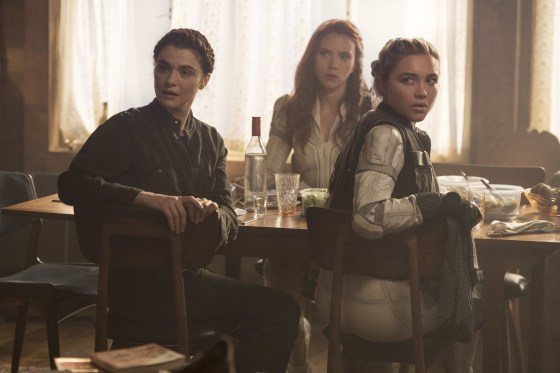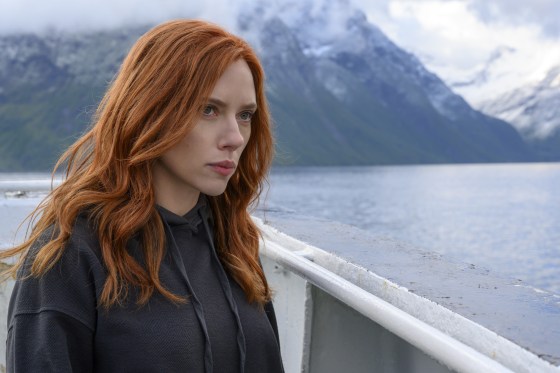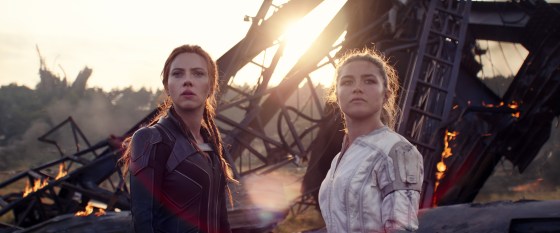Black Widow sauntered into the mainstream consciousness in 2010’s Iron Man 2. Not walked—sauntered. Natasha Romanoff, the Russian agent turned U.S. spy played by Scarlett Johansson, first meets Tony Stark, a.k.a. Iron Man (Robert Downey Jr.) when he’s working out in a boxing ring with his employee, played by Jon Favreau, the film’s director. Favreau’s Happy Hogan condescendingly offers to teach Natasha how to box, so she slips off her high heels, slinks into the ring and immediately kicks the man’s butt. That’s the joke: Surprise! This unbelievably fit woman can fight.
But it’s the moment after Natasha handily beats Happy that truly rankled fans. Stark turns to his assistant turned girlfriend Pepper Potts, played by Gwyneth Paltrow. “Who is she?” Tony asks. To which Pepper replies, “Potentially a very expensive sexual harassment lawsuit.” Tony, after Googling for photos of Natasha in her underwear, quips, “I want one.”
[time-brightcove not-tgx=”true”]
Victoria Alonso, executive vice president of production at Marvel Studios, never liked the line. “It bothered me then and it bothers me now,” says Alonso, who was a co-producer of Iron Man 2. “I remember thinking, ‘She’s not a thing.’ But how apropos: the world sees a sexy woman and thinks that because she is beautiful, that’s all she has to give.” The scene feels like a relic of a pre-#MeToo Hollywood.
And it was a different Hollywood, and certainly a different Marvel: for 10 years, more white men named Chris headlined Marvel movies than women and actors of color combined. It took 17 movies for the Marvel Cinematic Universe (MCU) to introduce a female villain (Cate Blanchett in 2017’s Thor: Ragnarok) and 21 to debut a solo female lead (Brie Larson in 2019’s Captain Marvel). Now, 11 years after she first appeared onscreen, the MCU’s first major female character is finally getting her own movie.
Black Widow, due July 9 in theaters and on Disney+ Premier Access, is a repudiation of the character’s retrograde origin story. After suffering countless indignities in nine preceding films—written as a seductress, an ogled object, a love interest, a self-described “monster” due to her infertility—Black Widow now headlines a movie that grapples directly with the very things that once oppressed her: sexism, objectification, even human trafficking.
Directed by Cate Shortland—the first solo female director of an MCU film—Black Widow makes a radical new female-dominated action space suddenly seem possible. It’s also a terrific film, a taut and tense spy thriller populated largely by female heroes and villains. Watching it ahead of its release, I found myself fantasizing about a woman-led Bond or Mission: Impossible. There have been efforts at female team-up action films before (Birds of Prey, Terminator: Dark Fate), but rarely executed so well. Critics agree, praising the well-crafted caper for giving an unsung hero her due.
The character’s reinvention owes much to the woman who originated the role. Over the years, Johansson fought to develop her into a fully realized human being. She helped improve Natasha with each film, even though no female screenwriters wrote for the character until now. (WandaVision writer Jac Schaeffer gets a story credit on Black Widow.) Now, Johansson’s an executive producer on Black Widow. When we spoke in March 2020, just before the pandemic would delay the movie’s release by more than a year, she said she’d frequently been asked why it hadn’t been made a decade ago. “And I’m like, ‘It couldn’t!’ It was a different climate. I wouldn’t have been able to have conversations [about sexism] with my director and see it actually translate onscreen.”
Usually characters in the MCU are introduced in a solo film before they join the big Avengers team-ups. So Black Widow’s most evolved iteration arrives both late in her story arc and at an odd time: the character died in Avengers: Endgame; Black Widow is a prequel set before that film. Johansson’s first and presumably last solo outing as Black Widow feels like a bittersweet tribute to the character that broke ground for the many women Marvel now spotlights. It also marks a new chapter for one of the most successful movie studios, one in which women, at long last, will redefine blockbusters for millions around the world.
Read More: Marvel Proved That Killing Off Those Avengers Was a Great Decision

Hollywood’s investment in female-led action and superhero films is an embarrassingly recent phenomenon. Even in the years after female-fronted adventure flicks like The Hunger Games and Frozen broke box-office records, Alonso argues that ingrained prejudices stymied the fight for representation in superhero movies. “There was always a myth that women’s stories don’t sell,” she says. “That super-heroes can’t be women. We had to demystify a bunch of these myths that were very much a part of what Hollywood was all about.”
These weren’t whispered notions. The 2014 Sony email hack contained a leaked missive with the subject line “female movies” sent by then Marvel Entertainment CEO Ike Perlmutter, arguing that such projects were not bankable. The email went viral just as female fans had begun to lobby for a Black Widow movie. But she remained a sidekick. “In the beginning she was used as a kind of chess piece for her male counterparts,” says Johansson. But in those dark years before Wonder Woman or Captain Marvel graced the big screen, feminist fans of genre film clung to her, flaws and all. She was all we had.
When it came to breaking that barrier for women, Warner Bros. beat Disney to the punch, shattering box-office records with Wonder Woman’s 2017 solo debut directed by Patty Jenkins. The character has a complicated 75-year history; Wonder Woman had been a feminist icon, a soldier, a pacifist and a sex symbol. And because the writer of the first Wonder Woman comics in the 1940s, William Moulton Marston, snuck in a lot of bondage imagery, the character’s power has always been intertwined with her sexuality.
The pressure on Jenkins—to satisfy fans hungry for a high-quality female superhero movie, to “stay true” to a comic-book origin that was alternately sexist and revolutionary, and, most of all, to strike gold at the box office—was immense. By waiting, Marvel spared itself the particular burden of proving that female superheroes can work.
</p> <p class="p1">She was a character created for the male gaze. Initially, even the way she moved, the way she dressed—it was helpful as a stepping-stone. But it wasn’t who she was.Read More: How Wonder Woman Broke Through
The studio also had some time to deal with Black Widow’s particular baggage. Like Wonder Woman, Black Widow has a backstory rooted in her sexuality: in her first comics appearance, she tries to seduce Tony Stark and spends much of her early comics runs mooning after Hawkeye. Natasha is just one of many “widows,” female Russian spies trained in the art of combat and (the films heavily imply) seduction. By the time she made her big-screen debut in Iron Man 2, she’s left that life behind, but she still deploys her sultry stare as a weapon. In her first scene in 2012’s Avengers, she’s tied up in a chair being interrogated by bad guys. She’s wearing a revealing dress and playing vulnerable until she breaks character and takes down the henchmen, wrists still bound.
In 2015’s Avengers: Age of Ultron, Natasha begins a romance with Bruce Banner (a.k.a. Mark Ruffalo’s Hulk). The story should have offered Johansson a chance to further explore the character’s motivations. But the actor notes that the plot line was “again dependent on another man’s desire.”
It was in this movie that Black Widow, in relating to Hulk’s insecurity over turning into an actual green beast, described herself as a “monster” because of her forced hysterectomy and inability to bear children. The line outraged fans who called out director Joss Whedon on Twitter. He left the platform soon after, though he told Buzzfeed that his departure was unrelated to the blowback and that “militant feminists” were always criticizing his work. (Whedon has since been accused of bullying behavior, particularly toward female and BIPOC actors, on sets.)
This treatment of Black Widow was not restricted to the movie scripts themselves. On the press tour for Avengers 2, actors Jeremy Renner and Chris Evans, when asked about Black Widow’s romantic history—she had had flirtations with Renner’s character Hawkeye, Downey’s Iron Man, Evans’ Captain America and Ruffalo’s Hulk over the course of a few films—joked that the character was “a slut,” setting off another Internet firestorm about the misogyny directed toward female action heroes on- and offscreen. (Both actors later apologized.)
Marvel is far from the only franchise reckoning with its past treatment of female characters as it tries to market itself as a hub of inclusive story-telling. After decades of complaints about Bond girls, this year’s Bond film, No Time to Die, got a script treatment from outspoken feminist and Fleabag creator Phoebe Waller-Bridge. (She has emphasized that she does not believe she was hired because of her gender.) And even as Jenkins created practical costumes for the Amazon warriors in her Wonder Woman movie, the two subsequent versions of the Justice League movie, directed by Zack Snyder and Whedon, respectively, cropped the armor to expose more skin.
Marvel has seemingly become more deliberate in its treatment of female characters. “I think there is a conscientious effort to not objectify women,” says Alonso. Its team-up movies have grown from featuring one woman to several. Avengers: Infinity War largely centered on the relationship Gamora (Zoe Saldana) and Nebula (Karen Gillan) had with their genocidal adopted father, Thanos (Josh Brolin).
Still, female superheroes continue to be outfitted in impractical heels and body-hugging suits. Alonso claims Marvel gets more criticism for objectifying men with “those shirtless scenes” than women. It’s hard to imagine this could be possible, though fair to assume that any flak along those lines has more to do with sexist double standards in society than with the studio having a worse track record with men than women.

Shortland had not seen all the Marvel movies before she signed on to direct Black Widow. Typically, she writes backstories for her characters, but she found Black Widow’s back catalog to be insufficient. “She was a character created for the male gaze,” says Shortland. “Initially, even the way she moved, the way she dressed—it was helpful as a stepping-stone. But it wasn’t who she was.” She invented a history for the character beyond the script, which she shared with Johansson, and they discussed what it would have been like for Natasha to grow up in Russia, watching the Soviet Union get dismantled.
Black Widow opens with Natasha’s childhood, which could easily slot into a Cold War espionage show like The Americans. Her “parents” are Russian sleeper agents living in Ohio, and in the thrilling opening act, the audience meets a different Natasha than the one we’ve seen before, a vulnerable child rather than a cold femme fatale. As an adult, she wears combat boots and a leather jacket more than her bodysuit, and both deals and takes the sort of brutal blows that few directors are willing to show in brawling scenes between women. Those gritty scenes are a potent reminder that in the spy genre, women have played arm candy far more than protagonists.
As the rest of the MCU grows increasingly cosmic, Natasha has remained grounded. She has no superpowers, a boon for viewers who have overdosed on special effects. When Natasha and her sister Yelena patch themselves up after a fight, Yelena points out that the “big” Avengers like the space god Thor probably don’t need to pop an ibuprofen after battle.
Black Widow is driven by the fraught relationship between these sisters. Set after the events of Captain America: Civil War when Natasha is a fugitive from the American government, the film finds her seeking to uncover the secrets of her childhood living with the agents masquerading as her family. Florence Pugh plays the younger “sister.” Rachel Weisz is the whip-smart matriarch. The only man, a father figure played by David Harbour, generously plays the butt of the jokes as the entitled man the women can send fleeing with their delightfully abundant talk of lady parts.
Perhaps the most surprising twist in the film is the way it deals with the character’s infertility. “Victoria [Alonso] and I are both adoptive mothers,” says Shortland. “We wanted to talk about the idea that the fact that you do not bear children does not mean that you are less than. We wanted to empower her.” Natasha and Yelena have frank conversations about children (or lack thereof), careers and their futures. They even make jokes—improbably funny ones—about their hysterectomies.
Read More: This Is Not Another Story About Captain Marvel’s Gender

When I first spoke to Johansson in March 2020, it was supposed to be a banner year for female directors. Studios still rarely grant women the chance to helm action epics, but last year was set to see the release of Black Widow, Wonder Woman 1984, Mulan and Eternals, all directed by women and predicted to do top-10 business at the box office. The promise of more equitable opportunities was coming to fruition. Instead, the pandemic drove those movies to trickle out in hybrid theatrical-streaming releases or to delay their releases until this year.
Johansson, who has worked on male-dominated action sets her whole career, believes a female director can crucially change the trajectory of a film. She credits Shortland with deeply interrogating her characters’ vulnerabilities and motivations. “Those curiosities, I’m not going to say they’re only female, but I do think they’re inherently female,” Johansson says.
Increasingly, despite the setbacks of the pandemic, promising female auteurs are getting tapped by the franchise machine. 2019’s Captain Marvel, co-directed by the female-male team of Anna Boden and Ryan Fleck, earned $1.1 billion. Chloé Zhao’s Oscar-winning Nomadland hadn’t yet debuted when Marvel signed her to direct this year’s Eternals starring Angelina Jolie. The studio has also tapped Candyman director Nia DaCosta to helm the second Captain Marvel film, The Marvels, which will star a cohort of female superheroes. Booksmart’s Olivia Wilde will direct a female-fronted Spider-Man spinoff, and Jenkins will return for Wonder Woman 3.
Marvel’s expansion to TV via Disney+ is also broadening storytelling opportunities for women. The debut of WandaVision in January represented a leap forward in female-centric storytelling, as it redeemed the arc of Wanda Maximoff (Elizabeth Olsen), the 14th-billed cast member in Avengers: Infinity War. The character had largely been defined by her lack of control over her powers, a trait that veers into stereotypes about overly emotional women who can’t help but destroy everything around them (see also: Dark Phoenix, Game of Thrones). But the show leaned into an exploration of Wanda’s emotions and served up a treatise on grief and mental health.
Read More: Wandavision Offers Hope That Originality Can Survive the Era of the Ever-Expanding Franchise
The studio seems to have decided to transform its shortcomings into strengths. After under-utilizing Natalie Portman as Thor’s love interest Jane, they’re promoting her to the Goddess of Thunder in 2022’s Love and Thunder. When director Taika Waititi bestowed the hammer on her at 2019’s San Diego Comic-Con, she accepted with a smirk that screamed, “It’s about time.”
Whether motivated by courage or shame, or perhaps a little of both, this willingness to stare down its own checkered past is critical to Marvel’s next phase. At one point during Black Widow, Yelena ribs Natasha about the infamous pose in which she lands with her legs splayed, gazing up seductively at the camera. It’s been around since the Iron Man era, a blatant male fantasy of how a woman would fight.
“I decided to make a point of it,” says Shortland. “Her sister says, ‘You’re a poser. The way you move, it’s not real. Who is it for?’ We were pointing at it, allowing the audience to be aware of what they had watched before and what they were watching now.” Marvel gets to have its cake and eat it too: Johansson still does the pose, after all. But there’s an unspoken promise that characters like Pugh’s and the ones that will populate upcoming MCU films and shows—like a young female Hawkeye, teen Muslim superhero Ms. Marvel and Iron Man’s successor Ironheart—could shed the expectations that burdened Black Widow and set a standard of true empowerment for the next chapter in this cinematic universe.

0 Comments